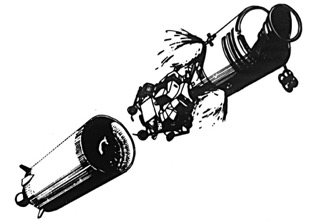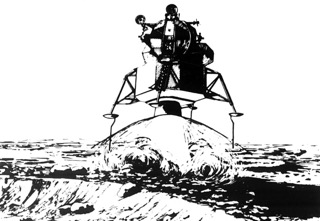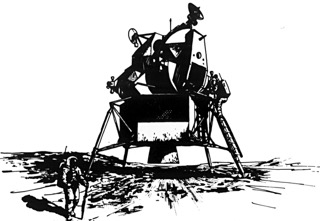Moon Phases | Learn All About the Moon
- Antoine & Dalia Grelin
- Feb 24, 2023
- 16 min read
Updated: Mar 20, 2024
The moon has 8 phases, each as beautiful as the next. Get information about the moon phases in order, photos of each phase, and discover interesting facts about the moon. Read further to see other moon-related topics such as Earthshine, lunar astrophotography, and more.

What are the Moon Phases?
There are 8 phases of the moon:
New Moon
Waxing Crescent
First Quarter
Waxing Gibbous
Full Moon
Waning Gibbous
Last Quarter
Waning Crescent
Each phase of the moon is noted by its appearance - which is covered in depth further below.
Everyone on Earth experiences the same order of moon phases. However, people who live directly on or below the equator experience the lunar cycle differently. Folks on the equator see the moon sideways! Southern hemisphere lunar phases appear upside down! If you travel away from your respective hemisphere, don't forget to look up at night!
What Causes the Phases of the Moon?
The moon orbits the Earth, and at the same time, the Earth is on a continuous course around the sun. As a result, viewers on Earth see the moon's surface brightness change in a regular pattern, called a lunar cycle, before starting over again. The changes have been categorized into stages called moon phases.
Ultimately, the different phases of the moon are caused by the amount of sunlight reflected on the moon's surface which changes due to the position of the Earth and moon relative to the sun.

The Moon Cycle
The moon orbits the Earth at nearly the same rate when it reaches a complete rotation. The name of this event is the moon cycle, which is also referred to as the lunar cycle. How many days are in a moon cycle? From start to finish, a moon cycle lasts about 29.53 days.
On Earth, 30 days is the typical number of days in a month, meaning it is possible to see every phase in one month but only if the time is right.

It is not certain you will see each phase in a month because of the changing number of days per month (i.e. January has 31 days, February has 28 or 29 days, etc.).
This shifts the lunar calendar to a different schedule than the Gregorian calendar - which most of the world uses. In short, a lunar phase calendar is not the same as a regular calendar.
Moon illumination is the amount of light from the sun reflected on the moon, and is measured by percentage. For example, during the new moon, the percentage of illumination is at 0%; and during the full moon phase, it is at 100%.
Types of Moon Phases: Primary and Secondary
The lunar phases are categorized into two groups: primary and secondary. Most people are familiar with the four major phases in the primary category:
New moon
First quarter
Full moon
Third quarter
The secondary category holds the minor phases:
Waxing crescent
Waxing gibbous
Waning gibbous
Waning crescent

Phases of the moon diagram | Credit to JPL + NASA
Below you will find information about each of the moon phases including the name, an image, illumination, and a short description.
1. New Moon

Illumination: 0%
Description: At zero percent illumination, we cannot see the moon. The position of the moon during a new moon is between the earth and the sun, so the side facing the sun is illuminated and the side facing the earth is dark. In other words: no light, no moon. It is also only during a new moon that a solar eclipse occurs.
2. Waxing Crescent Moon

Illumination: 0.1to 49.9%
Description: In the waxing crescent phase, the moon is illuminated on the right side in a crescent shape. The position of the sun, moon, and earth are at a nearly perpendicular angle creating the crescent effect. The word waxing comes from Old English and in this context means "to increase."
3. First Quarter Moon

Illumination: 50%
Description: In the first quarter moon phase, the moon is half-illuminated on the right side because the sun, the moon, and the earth are at a 90-degree angle. The quarter moon is often called a "half moon," which can be tricky as the name refers to the position in the moon cycle, while the nickname refers to its appearance. The first quarter moon rises at noon and sets at midnight.
4. Waxing Gibbous Moon

Illumination: 50.1 to 99.9%
Description: The waxing gibbous moon phase occurs immediately after the first quarter moon sets at midnight. It is illuminated on the right side and continues to wax (increase) until the moon is full. The term gibbous in this context refers to the shape of the illuminated part of the moon which is between a semicircle and a circle.
5. Full Moon

Illumination: 100%
Description: During a full moon, the entire surface of the moon facing the Earth is illuminated. In the full moon phase, the Earth is located between the moon and the sun. For visual observers, the moon can be a fun target to look at, but not for astrophotographers. This is also the only time when a lunar eclipse may occur.
6. Waning Gibbous Moon

Illumination: 99.9 to 50.1%
Description: The waning gibbous moon phase begins after the peak of the full moon. The word waning in this context means "to shrink." That means the illuminated area of the moon is getting smaller and this happens on its left side.
7. Last Quarter Moon

Illumination: 50%
Description: Also called the "third quarter moon," the last quarter moon phase occurs when the moon is at a right angle to the sun. Similar to the first quarter moon, this phase is half-illuminated but now on the left side. It rises at 12 am and sets at noon.
8. Waning Crescent Moon

Illumination: 49.9 to 0.1%
Description: The waning crescent moon phase is the last phase of the cycle before it starts over with the new moon.
In this phase, the illuminated area appears as a shrinking crescent on the moon's left side.
Now that you are familiar with all of the moon's phases, share that knowledge with friends and family. If you are an astrophotographer, it's important to know the moon phases to determine the best time to image.
What Phase Is the Moon In Tonight?
There are many free resources to help you discover what the current lunar phase is. Or perhaps you're wondering when is the new moon? Take the guesswork out and check out the following websites and apps.
Websites to track the Moon Phases
If you want to know what phase can be seen tonight, look up and try to spot the moon! However, you may have an easier time checking out a website instead to discover the current lunar cycle. Below are a few of the most popular websites you can use. We'll also give you the top apps to track the moon phases.
TimeandDate.com
This website shows you all the timing information you need about the moon, sun, and more. Check out their Moon Phases tab to discover what the next new moon is, what phase the moon is in tonight, and more.

Moonpage
If you're looking for something minimalistic, this is it! Moonpage will simply show you the current phase of the moon and the percentage of illumination... and that's it!
Moongiant
Another great website to check the current phase of the moon is Moongiant. Here, you can also see some important information about the current moon phase, and select other days on the calendar to know which phase to expect.
NASA
Of course, NASA has a dedicated page about the moon phases! This is great to not only see the current lunar phase but also to learn much more about the moon in general. They also have a nice interactive section where you can use a slider to see how the moon phases change each day, pretty cool!

Apps to Track the Moon Phases
You can also use a planetarium software or smartphone app and select your desired date to see the exact position and phase of the moon. Some of the most popular ones are:
SkySafari
This is the planetarium app/software we use on our phones and computers. It is very useful in demonstrating exactly where the moon is, how illuminated it is, and what time it rises or sets. SkySafari is also a fantastic planetarium for anything deep-sky related.

Stellarium
Similar to SkySafari, and completely free, Stellarium is a fantastic app available on smartphones and computers. Stellarium is by far the most popular planetarium app and software in the astronomy and astrophotography community.
SkyChart
SkyChart is available on smartphones and is a simple app to use to see the entmire sky, including the moon at any date and time. It also has a nice advanced reality feature where you can aim your phone at the sky to see which stars are currently above your head.
Sundial
Sundial is a basic app for checking the current moon phases, and what time it rises/sets. It also includes the rise and set times of the sun. Another nice feature is that this app can be installed on your smartwatch, to quickly see basic moon information!

PhotoPills
PhotoPills is a great app designed for nighttime photographers. It excels at giving you important information about the Milky Way, but it also has plenty of information about the moon and the lunar cycle.
Knowing what the moon's phase is for the day can be helpful for both visual observers in astronomy and astrophotographers. We have a section about astrophotography next, so check it out for tips on your Astro-imaging journey.
The Moon and Deep Space Astrophotography
Astrophotography is taking photographs of space. With even the simplest of gear, you can get images of constellations, nebulae, galaxies, and even comets.
The way it is accomplished is by letting the camera take long exposure shots during the night. A common question regarding the moon for astrophotographers is when is the new moon? Why? The darker the sky, the better! The following day, you upload the photographs to a computer where you can use software to "stack" all the data into a single image which you then process to bring out as much detail and color as possible.
Feel free to click on the images below to learn more about how these were captured.
One of the most important aspects of astrophotography is to have as dark and clear skies as possible. Light pollution and other obstacles are factors that could impact an imaging session, but the biggest one you can plan for is the moon - thanks to its cyclical phases. Earth's satellite is the brightest object in the sky at night, and it can impact the image quality of the distant target you are aiming for. Therefore, it is best to photograph deep sky objects in the evenings before, during, and after the new moon.
New Moon: Peak Imaging Time
Does that mean you have to wait for a new moon to do astrophotography? No. You can certainly image during any of the moon phases, but again, because of the long exposures your camera is taking, the image quality may get washed out by the moon's brightness. One way to combat the moon's brightness during deep sky astrophotography is to use narrowband filters, but the moon would still be a problem if it is located close to your target in the sky.
The same principle occurs when you are stargazing. For example, imagine you are in a designated dark sky park, such as Great Basin National Park. Your view of the stars would be overwhelming! Hardly any part of the night sky is not completely dotted with stars. Now, imagine the full moon is starting to rise over the peak of a mountain. Every moment that passes, your vision is impacted by the illumination of the bright moon, and suddenly, the once overwhelming sky of stars has disappeared into the light glow.
Your eyes, similar to a camera lens, were able to see the light of those far-away stars because your view was free from other light sources. As soon as the moon appeared, your eyes could only capture the light closest to you washing out everything else in the sky. Remember this when imaging and consider imaging around the new moon phase.
So when is the next New Moon? There are many free resources to help you discover each of the moon phases. Take the guesswork out and check out the websites we mentioned earlier!
If you've read this article, you're set to start your astrophotography journey! Your newfound knowledge about the moon phases can help you decide when it is best to image or stargaze. If you're curious about astrophotography, read our full Beginner Astrophotography guide or become a member of the Galactic Course!
Taking Pictures of the Moon - Lunar Photography
Lunar imaging is also a big part of astrophotography and it is extremely different from deep space photography! Instead of long exposures and stacking dozens of images, you'll be either shooting a single image with your camera or creating an image out of a short video.
The moon with a smartphone
There are several ways to capture a beautiful picture of the moon. For a complete beginner, we suggest using your smartphone to try snapping your very first pic of the moon. You can get your hands on a pair of binoculars, place them on a tripod, and shoot through one of the eyepieces.
The picture on the left was taken exactly like this and was our first successful image of the moon.
Note: That specific picture was not taken with a smartphone but with an old and cheap Point & Shoot camera from 2005... Any smartphone nowadays can do much better in terms of resolution!
The Moon with a DSLR or Mirrorless Camera
If you own a DSLR or mirrorless camera, you can purchase a telephoto lens (we recommend one that can go up to 200 or 300mm).
Place your camera on a tripod, aim it at the moon with the lens fully zoomed in, manually focus on the craters, and take a picture!
Be sure to be in Manual mode, the settings will depend on the camera and the current phase of the moon, so take your time and try a few until you get something nice.
If you have no idea where to start, do the following:
ISO: 100-200
Aperture: f/11 - f/16
Shutter Speed: 1/125 - 1/250
The Moon with an Astronomy Camera
Lastly, if you become a moon lover and want to get deeper into Lunar Astrophotography, get yourself a dedicated planetary camera! These cameras are usually small and affordable and are the best for capturing planets and the moon with a telescope.
The learning curve here will go up tremendously from your DSLR era because you will need to shoot videos instead of pictures and stack your desired percentage of "best frames" to create one image, but it will be worth it.
The image below, as an example, was taken with a planetary camera under $300 and a small beginner telescope. You can see the beautiful and defined craters of the moon.
Did you already take some cool pictures of the moon? Feel free to attach them in the comments section for everyone to see!
Earthshine: What Is It?
Have you ever seen the part of the moon that isn't illuminated? It's much fainter than the crescent shape, but you can still see the surface slightly. That effect is called Earthshine.
Earthshine occurs when the light reflected from the moon bounces to the earth and back to your eyes. When that happens, the light illuminates the surface of the moon facing the Earth. The moon is not as reflective as the earth which explains why the unlit area is much fainter. Typically, earthshine is seen during the crescent phases (waxing or waning) so there's a good chance you might catch it if you look up.

It's interesting to think back on what people thought about Earthshine. In the past, there was a phrase that described this effect saying, "the old moon in the new moon's arms", and conversely, "the new moon in the old moon's arms."
Special Moon Events and Eclipses
When certain events line up astronomically on Earth, the moon can appear different than normal. Usually, this doesn't involve the other moon phases - just the full moon. You may have heard of the phrase "once in a blue moon" and wondered what that meant. Below is a short list of special lunar events you may have heard of.
Blue Moon
A blue moon can mean two things: a moon appears to be the color blue (when dust in the atmosphere makes it look this way), and a full moon occurs twice in the same calendar month.
The context for this article is the latter. A moon cycle lasts about 29 days, so it is possible to have a second full moon in one month as most calendar months have 30 or 31 days. Online sources may be a good way to find out when the next blue moon is because they're quite rare, and having more than one blue moon per year is even rarer.
Blood Moon

A blood moon may sound frightening, but it's all in the name.
This phenomenon occurs only during a total lunar eclipse of the Earth's moon.
Most of the time, the Earth and the moon orbit on different planes making a blood moon uncommon. However, when they do happen to meet, a total lunar eclipse occurs and you can see the color of the moon turn a red or reddish brown color.
Harvest Moon
A harvest moon marks an important time of year and occurs when the full moon is closest to the earth (at perigee) during the autumnal equinox.
What does it mark? The autumn harvest of course! Farmers typically collect their harvest toward the end of summer into the beginning of autumn or fall. In the past, farmers would stop working after the sun went down. During the Harvest Moon, they used the full moon's light to continue working into the evening.
Supermoon
Unfortunately, a cape doesn't come with a supermoon. When the moon reaches perigee in orbit, it is at its closest point to the earth. When a full moon coincides with the orbit's perigee it makes the moon appear larger than normal, creating a supermoon. It might not be rare, but it is a sight to behold and may occur a few times a year.

Solar Eclipses
A solar eclipse occurs when the moon passes between the sun and Earth. Solar eclipses usually occur 2-4 times each year depending on where you live. Total eclipses are rare and only happen once every few years, but are some of the most impressive events you can ever see!
A total solar eclipse, annular solar eclipse, and partial solar eclipse
There are four types of solar eclipses:
The most impressive type of eclipse. This occurs when the moon covers the sun perfectly, as it passes over it through the path of totality.
Similar to a total solar eclipse, the moon this time does not fully cover the sun because of its distance on that specific day making the moon appear smaller. The most unique feature of Annular solar eclipses is the "Ring of Fire".
Partial Solar Eclipse
Partial solar eclipses happen when the moon only covers a part of the sun and does not pass exactly over it. This happens because the path of totality does not exist at the current observing location.
Hybrid Solar Eclipse
This is rare and happens when the eclipse goes from total to annular depending on the observation point.
Read our full post about solar eclipses to learn more and see a table full of information about all the upcoming eclipses until the year 2100.
How Many Times Have Humans Landed on the Moon?
Six U.S.-led missions have put humankind on the moon. 24 humans have been to the moon, and 12 men have set foot on the moon.

Apollo 11
Lunar Lander: Eagle
Lunar Landing Date: July 20, 1969
Lunar Landing Site: Sea of Tranquility
Duration on Lunar Surface: 21 minutes and 31 seconds
Crew: Neil Armstrong | Edwin "Buzz" Aldrin

Apollo 12
Lunar Lander: Intrepid
Lunar Landing Date: November 19, 1969
Lunar Landing Site: Ocean of Storms
Duration on Lunar Surface: 1 hour, 7 minutes, and 31 seconds
Crew: Charles "Pete" Conrad | Alan Bean

Apollo 14
Lunar Lander: Antares
Lunar Landing Date: February 5, 1971
Lunar Landing Site: Fra Mauro
Duration on Lunar Surface: 1 hour, 9 minutes, and 30 seconds
Crew: Alan B. Shepard | Edgar Mitchell

Apollo 15
Lunar Lander: Falcon
Lunar Landing Date: July 30, 1971
Lunar Landing Site: Hadley Rille
Duration on Lunar Surface: 2 hours, 18 minutes, and 55 seconds
Crew: David Scott | James Irwin

Apollo 16
Lunar Lander: Orion
Lunar Landing Date: April 21, 1972
Lunar Landing Site: Descartes Highlands
Duration on Lunar Surface: 2 hours, 23 minutes, and 2 seconds
Crew: John Young | Charles Duke

Apollo 17
Lunar Lander: Challenger
Lunar Landing Date: December 11, 1972
Lunar Landing Site: Taurus-Littrow
Duration on Lunar Surface: 3 hours, 2 minutes, and 59 seconds
Crew: Eugene Cernan | Harrison "Jack" Schmitt
1972 was the last time humans landed on the moon, but maybe not for much longer! NASA and other space agencies are nowadays putting manned lunar landings back to the top of their priority lists, and we likely will see new humans land on the moon in our lifetime.
1969 drawings of the plan to land humans on the moon
Below is an annotated image of the moon with the missions, their badges, points of interest, and photo souvenirs. It is nice to be able to see all the landing spots in one single image. We captured this photo during Episode 7 of Galactic Hunter which you can watch on YouTube.

Fun Facts About the Moon
The light we see from the moon is SUNlight.
The moon does NOT produce its light. The only light source in the Solar System comes from THE sun. The sun, or "sol," is also the namesake for the Solar System.
Looking at the moon through a telescope or binoculars for long periods is not recommended.
You know never to look directly at the sun. And now that you've read the fun fact above, you know the light you see from the moon is reflected directly from the sun. Despite seeming safer, it is still damaging for your eyes to stare at any of the moon phases for long periods because what you're really looking at is indirect sunlight.

If you're an astrophotographer, your camera lens is your protection. If you're a visual observer, take care of your eyes, you can either get a moon filter or maybe wear sunglasses at night. Cue song. 😎
The new moon phase is the only time a solar eclipse occurs.
Does that mean every new moon is a solar eclipse? No. Depending on where the Earth is in orbit and if the moon is in the right position, it's uncommon when they do line up.
The moon WOBBLES.
You read that right! The moon wobbles. It is also another reason why solar eclipses are uncommon. NASA has a great video demonstrating the effect.
Earth's moon is the only moon in the Solar System to experience the earthshine effect.
If you want to brag about something, brag about the Earthshine effect! It's not something other planets can say is true - so take that, Mars.
Can I see the Moon in the Daytime?
Yes, you can! Even during the daytime, the moon can be seen in the sky. Depending on your location and where it is in the sky, you can see the Earth's satellite moving across the sky during the day. Some moon phases are easier to spot than others. Unlike the stars that get washed out by moonlight at night, the moon is bright enough to see even during daylight hours.

Final Thoughts
We hope this post helped you get a better sense of how the moon cycle works, and that you now have a better understanding of each of the moon phases!
If you are a deep space astrophotographer, you might not be too fond of the moon because it only brings light pollution when it is up in the sky, but try to make the best of it and get some nice shots of our natural satellite anyway!
Over the years, we got some nice and creative shots of our moon that we really love.
If you liked this post, you might also like our full guide about all the planets in order from the sun, so be sure to check that out to learn all about the planets in our solar system. You might also find our blog post about the upcoming solar eclipses interesting.
Antoine & Dalia Grelin
Galactic Hunter









































